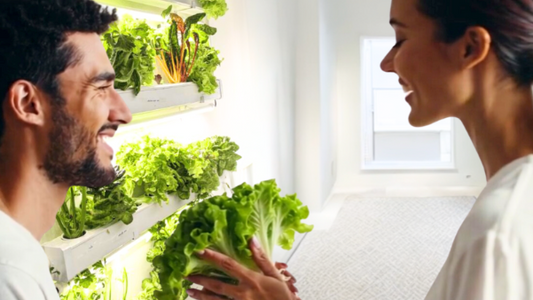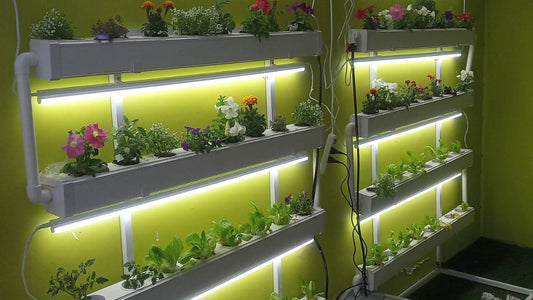By Nature Tech
A Revolution in How We Grow Food
Every meal we eat has a hidden impact—on the environment, our health, and the way cities function. But what if we could grow fresher, healthier food while reducing pollution, conserving water, and making cities more livable?
That’s exactly what urban farming and hydroponics are doing. Across the world, from the rooftops of New York to high-tech vertical farms in Singapore, a quiet revolution is reshaping agriculture. And it’s not just about sustainability—it’s about survival.
With global food demand expected to double by 2050, traditional farming is struggling to keep up. The consequences? Severe water shortages, soil depletion, and massive carbon emissions from industrial agriculture. Meanwhile, city populations are growing, increasing demand for fresh, healthy food.
The solution? Bringing agriculture into our cities. Hydroponics and urban farming aren’t just futuristic trends—they’re rapidly becoming essential for food security, climate resilience, and human health.
In this article, we’ll explore why urban farming is crucial for the planet, how hydroponics is revolutionizing food production, and why this shift matters for your health and well-being.
A New Evolution in Agriculture

Throughout history, food production has evolved—from foraging and hunting to home farming and, eventually, large-scale industrial agriculture. Today, we stand at the precipice of a new agricultural revolution, driven by necessity and aligned with the ecological challenges of our time.
Maslow’s hierarchy of needs identifies clean air, clean water, and adequate nutrition as fundamental human necessities. However, global reports paint a concerning picture:
- Air pollution is expected to become the leading cause of death by 2050, with 3.6 million people per year dying from related illnesses (OECD, 2022).
- Global freshwater supplies are depleting, with agriculture consuming 70% of the world’s freshwater (FAO, 2021).
- Arable land is shrinking due to urbanization and soil degradation, threatening global food security (UNEP, 2022).
We cannot afford to rely solely on conventional farming methods. Urban agriculture, and hydroponics in particular, presents a crucial alternative.
The Environmental Cost of Traditional Agriculture

Agriculture is a major contributor to climate change, responsible for approximately 24% of global greenhouse gas emissions (IPCC, 2021). While transportation and industry often receive more blame, the cumulative impact of industrial-scale farming, deforestation, and soil degradation surpasses many other sectors.
Key Environmental Challenges of Traditional Farming:
- Deforestation – Millions of acres of rainforest are cleared annually for agricultural use, reducing biodiversity.
- Soil Depletion – Overfarming and chemical fertilizers degrade soil quality, reducing future crop yields.
- Water Consumption – Conventional agriculture uses vast amounts of water, leading to resource depletion.
- Methane Emissions – Livestock farming contributes to 14.5% of global greenhouse gas emissions, with methane having 80 times the warming potential of CO₂ over 20 years (FAO, 2021).
We must rethink how and where we grow food. This is where urban hydroponic farming can play a game-changing role.
How Urban Agriculture and Hydroponics Provide Solutions

1. Eliminating Dependence on Farmland
Hydroponic farming does not require soil, meaning it can be implemented on rooftops, in basements, and within urban spaces. This eliminates the need for deforestation, extensive land use, and environmentally harmful fertilizers.
Proven Benefits:
-
Hydroponic farms can yield up to 100 times more produce per square meter than traditional soil farming (Resh, 2020).
-
The localized nature of urban farming reduces the carbon footprint associated with long-distance food transportation.
-
Hydroponics requires 90% less land, allowing cities to reclaim spaces for biodiversity and conservation efforts.
2. Reducing Water Usage by Up to 90%
Agriculture is the largest consumer of freshwater resources worldwide, but hydroponic farming can cut that dramatically.
- Hydroponic systems use only 10% of the water required by traditional farming (NASA, 2022).
- Some hydroponic setups, such as aeroponics, achieve water savings of up to 99%, offering a solution for drought-prone regions.
3. Improving Air Quality in Cities
The urban heat island effect and pollution levels in densely populated areas are rising concerns. Plants, through photosynthesis, naturally filter carbon dioxide and produce oxygen.
- Expanding urban agriculture adds millions of oxygen-producing plants, directly counteracting air pollution.
- Hydroponic vertical farms absorb CO₂ and release oxygen, improving air quality in densely populated areas.
4. Strengthening Local Economies & Job Creation
Hydroponic urban farming is not just about sustainability—it’s about economic transformation.
- Cities investing in hydroponic agriculture have seen local job creation skyrocket (NYC AgTech Report, 2023).
- Local food production reduces reliance on imports, keeping more economic value within communities.
- Many governments now offer incentives, tax breaks, and urban farming grants to encourage sustainable city agriculture.
5. Enhancing Energy Efficiency & Building Insulation
Green rooftops act as insulators, reducing heating and cooling costs for buildings.
- This lowers overall energy consumption and contributes to a city’s climate resilience strategy.
- Countries like Germany and Canada have implemented policies encouraging rooftop agriculture as part of urban planning.
6. Healthier, Fresher Food with Higher Nutritional Value
Consumers are increasingly concerned about pesticide use and food freshness.
- Israel has the highest pesticide use per capita in the OECD, raising health concerns (OECD, 2022).
- Urban hydroponic farms produce pesticide-free, highly nutritious crops, ensuring food is fresher, healthier, and safer.
- Farm-to-table models reduce time from harvest to consumption, preserving more nutrients.
The Future of Urban Farming: A Call to Action
Hydroponic urban farming is no longer a futuristic concept—it is a practical, scalable solution to some of the most pressing environmental, economic, and health challenges facing humanity today.
What Can You Do?
- Support Local Urban Farms – Buy from farmers' markets and urban farm initiatives.
- Advocate for Policy Changes – Encourage city governments to implement hydroponic incentives.
- Try Hydroponics at Home – Small-scale hydroponic kits make growing food at home easy and sustainable, search our website for some ideas and options.
A Vision for the Future
"As cities evolve, so must our food systems. The future is not just about growing food—it’s about growing smarter, cleaner, and closer to home. Urban hydroponics is not just a trend; it’s the foundation of a more resilient, self-sustaining future."
The time for action is now. The world’s food system is shifting—will you be part of the revolution?
References & Sources
Here’s how it looks based on your instructions:
-
Food and Agriculture Organization (FAO), 2021.
- The Future of Food and Agriculture: Trends and Challenges.
- Retrieved from: www.fao.org
-
Intergovernmental Panel on Climate Change (IPCC), 2021.
- Climate Change and Land: Special Report on Climate Change, Desertification, and Food Security.
- Retrieved from: www.ipcc.ch
-
World Wide Fund for Nature (WWF), 2018.
- Living Planet Report: Agriculture and Its Impact on Biodiversity.
- Retrieved from: www.wwf.org
-
OECD, 2022.
- Air Pollution and Climate Change: Global Projections for 2050.
- Retrieved from: www.oecd.org
-
United Nations Environment Programme (UNEP), 2022.
- Global Land Outlook: The Future of Arable Land.
- Retrieved from: www.unep.org
-
NASA, 2022.
- Hydroponic Agriculture and Water Conservation: A Sustainable Solution.
- Retrieved from: www.nasa.gov
-
Markets and Markets, 2023.
- Vertical Farming Market Projections to 2030.
- Retrieved from: www.marketsandmarkets.com
-
New York City AgTech Report, 2023.
- Urban Farming and Job Creation: The Economic Benefits.
- Retrieved from: www.nyc.gov
-
CBS Israel, 2021.
- Agriculture in Israel: Workforce Trends and Challenges.
- Retrieved from: www.cbs.gov.il
-
Resh, H.M., 2020.
- Hydroponic Food Production: A Definitive Guide for Advanced Home Growers and Commercial Farmers.
- CRC Press
-
FAO, 2020.
- Agriculture’s Carbon Footprint: The Role of Livestock and Soil Management.
- Retrieved from: www.fao.org
-
OECD, 2021.
- Pesticide Use in Agriculture: Risks and Regulations.
- Retrieved from: www.oecd.org





